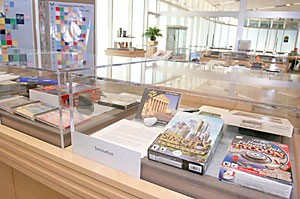Video games aren’t just for playing anymore.
The newest exhibit at the UA Library Special Collections showcases video games through history and the communities that gaming creates, said Ken McAllister, co-director of the Learning Games Initiative and an associate professor of English.
The exhibit, “”Documenting Digital Play,”” which is also featured in the UA Science-Engineering Library, is not only historical, but is also an attempt by special collections and LGI to show visitors that gaming is not an isolated experience and that many communities are created by games, McAllister said.
LGI started in Tucson in 1999 and aims to study, build and teach with video games to better understand their cultural implications and how they can be used for learning, said Judd Ruggill, a UA media arts instructor and co-director of LGI.
Games always teach multiple concepts in multiple ways – including resource management, spatial organization and conflict management – or at the very least, the skills needed to play a particular game, Ruggill said.
“”People like to play (video games), and when people like to do something, the learning is transparent,”” he said. “”Games are useful for teachers and students of all ages, because when people enjoy learning, it becomes more effective.””
There are many different types of communities created by video games, and an academic setting is the perfect place for all of them to come together … where the resources exist to investigate all the different aspects of games, McAllister said.
“”In many cases, there is a sense that video games are a ‘trendy’ thing to study,”” he said. “”But many institutions aren’t investing in gaming as an academic endeavor. They’re hung up on the idea that play is not worth studying. If it’s not serious, it’s not worth studying.””
The environment for video games is changing slowly, and there are more than 100 degree programs in the United States in game studies or game development. This number is likely to grow as institutions come to recognize the cultural and economic importance of the game, McAllister said.
The exhibit at Special Collections is a small part of the changing environment of gaming, and Bill Tsitsos, a UA sociology instructor, said he brought his sociology of pop culture class to study the community building that games create.
“”It was very nostalgic, it reminded me of my childhood,”” said Elena Cantu, a psychology senior and a member of the class. “”Games have had such a large impact on society and technology. They’re a major part of our lives.””
The exhibit will run until April 28. It is located on the southwest corner of East University Boulevard and North Cherry Avenue. Hours are Monday through Thursday 9 a.m. to 6 p.m., Friday 9 a.m. to 5 p.m., and Saturday from noon to 4 p.m.









